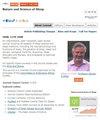Association Between EEG Microarousal During Nocturnal Sleep and Next-Day Selective Attention in Mild Sleep-Restricted Healthy Undergraduates
IF 3
2区 医学
Q2 CLINICAL NEUROLOGY
引用次数: 0
Abstract
Purpose: To explore whether sleep electroencephalogram (EEG) microarousals of different standard durations predict daytime mood and attention performance in healthy individuals after mild sleep restriction.Participants and Methods: Sixteen (nine female) healthy college students were recruited to examine the correlations between nocturnal EEG microarousals of different standard durations (≥ 3 s, ≥ 5 s, ≥ 7 s, ≥ 9 s) under mild sleep restriction (1.5 h) and the following morning’s subjective alertness, mood, sustained attention, and selective attention task performance.
Results: Results revealed that mild sleep restriction significantly reduced subjective alertness and positive mood, while having no significant effect on negative mood, sustained attention and selective attention performance. The number of microarousals (≥ 5 s) was negatively associated with positive mood at 6:30. The number of microarousals was significantly and positively correlated with the response time difference value of disengagement component of the selective attention task at around 7:30 (≥ 5 s and ≥ 7 s) and 9:00 (≥ 5 s). The number of microarousals (≥ 7 s) was significantly and positively correlated with the inaccuracy difference value of orientation component of the selective attention task at around 9:00.
Conclusion: The number of EEG microarousals during sleep in healthy adults with mild sleep restriction was significantly and negatively related to their daytime positive affect while positively associated with the deterioration of disengagement and orientation of selective attention performance, but this link is dependent on the standard duration of microarousals, test time and the type of task.
Keywords: microarousal, alertness, sustained attention, selective attention, sleep restriction
轻度睡眠受限的健康大学生夜间睡眠期间脑电图微唤醒与次日选择性注意之间的关系
目的:探讨不同标准持续时间的睡眠脑电图(EEG)微动量是否能预测轻度睡眠限制后健康人白天的情绪和注意力表现:招募16名(9名女性)健康大学生,研究轻度睡眠限制(1.5小时)下不同标准持续时间(≥3秒、≥5秒、≥7秒、≥9秒)的夜间脑电图微动与次日早晨主观警觉性、情绪、持续注意力和选择性注意力任务表现之间的相关性:结果发现,轻度睡眠限制会明显降低主观警觉性和积极情绪,而对消极情绪、持续注意和选择性注意表现没有显著影响。在 6:30 时,微唤醒次数(≥ 5 秒)与积极情绪呈负相关。在 7:30 左右(≥ 5 秒和≥ 7 秒)和 9:00 左右(≥ 5 秒),微唤醒次数与选择性注意任务中脱离部分的反应时差值呈显著正相关。在 9:00 左右,微动量(≥ 7 秒)的数量与选择性注意任务中定向部分的不准确性差异值呈显著正相关:轻度睡眠限制的健康成年人睡眠期间脑电图微动的次数与他们白天的积极情绪显著负相关,而与选择性注意的脱离和定向性能的恶化正相关,但这种联系取决于微动的标准持续时间、测试时间和任务类型。
本文章由计算机程序翻译,如有差异,请以英文原文为准。
求助全文
约1分钟内获得全文
求助全文
来源期刊

Nature and Science of Sleep
Neuroscience-Behavioral Neuroscience
CiteScore
5.70
自引率
5.90%
发文量
245
审稿时长
16 weeks
期刊介绍:
Nature and Science of Sleep is an international, peer-reviewed, open access journal covering all aspects of sleep science and sleep medicine, including the neurophysiology and functions of sleep, the genetics of sleep, sleep and society, biological rhythms, dreaming, sleep disorders and therapy, and strategies to optimize healthy sleep.
Specific topics covered in the journal include:
The functions of sleep in humans and other animals
Physiological and neurophysiological changes with sleep
The genetics of sleep and sleep differences
The neurotransmitters, receptors and pathways involved in controlling both sleep and wakefulness
Behavioral and pharmacological interventions aimed at improving sleep, and improving wakefulness
Sleep changes with development and with age
Sleep and reproduction (e.g., changes across the menstrual cycle, with pregnancy and menopause)
The science and nature of dreams
Sleep disorders
Impact of sleep and sleep disorders on health, daytime function and quality of life
Sleep problems secondary to clinical disorders
Interaction of society with sleep (e.g., consequences of shift work, occupational health, public health)
The microbiome and sleep
Chronotherapy
Impact of circadian rhythms on sleep, physiology, cognition and health
Mechanisms controlling circadian rhythms, centrally and peripherally
Impact of circadian rhythm disruptions (including night shift work, jet lag and social jet lag) on sleep, physiology, cognition and health
Behavioral and pharmacological interventions aimed at reducing adverse effects of circadian-related sleep disruption
Assessment of technologies and biomarkers for measuring sleep and/or circadian rhythms
Epigenetic markers of sleep or circadian disruption.
文献相关原料
| 公司名称 | 产品信息 | 采购帮参考价格 |
|---|
 求助内容:
求助内容: 应助结果提醒方式:
应助结果提醒方式:


